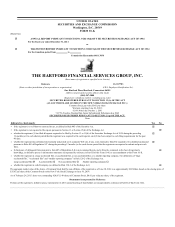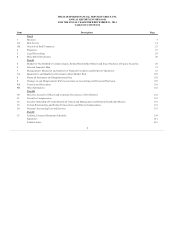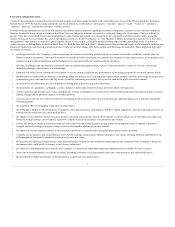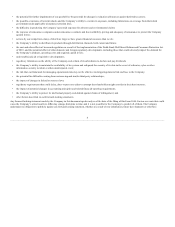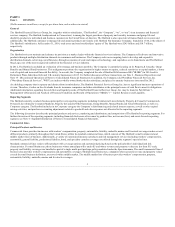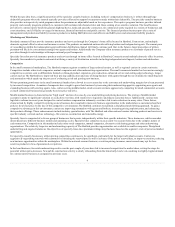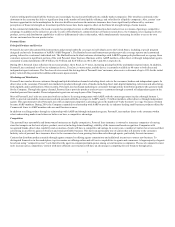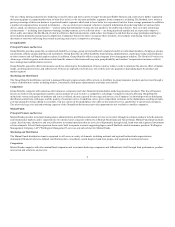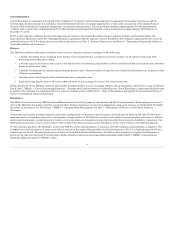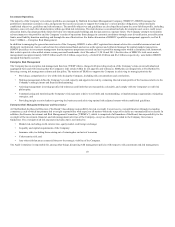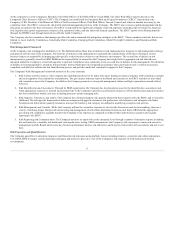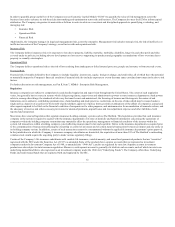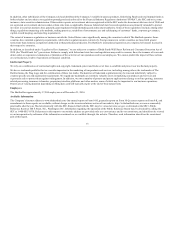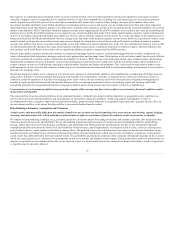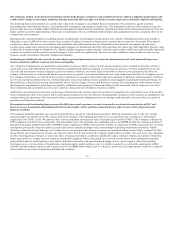The Hartford 2014 Annual Report Download - page 6
Download and view the complete annual report
Please find page 6 of the 2014 The Hartford annual report below. You can navigate through the pages in the report by either clicking on the pages listed below, or by using the keyword search tool below to find specific information within the annual report.
Within the specialty lines, a significant portion of the specialty casualty business, including workers’ compensation business, is written through large
deductible programs where the insured typically provides collateral to support loss payments made within their deductible. The specialty casualty business
also provides retrospectively-rated programs where the premiums are adjustable based on loss experience. The captive programs business provides tailored
property and casualty programs primarily to customers with common risk characteristics and those seeking a loss sensitive solution. The bond business
provides (1) contract surety bonds for general, highway/heavy, trade and specialty contractors; (2) commercial surety required in a variety of businesses and
court situations; and (3) fidelity coverage for businesses, financial institutions and public entities. The financial products business provides a suite of
management and professional liability insurance products including D&O (directors and officers) and E&O (errors and omissions) liability products.
Marketing and Distribution
Standard commercial lines provide insurance products and services through the Company’s home office located in Hartford, Connecticut, and multiple
domestic regional office locations and insurance centers. The products are marketed nationwide utilizing brokers and independent agents. The current pace
of consolidation within the independent agent and broker distribution channel will likely continue such that, in the future a larger proportion of written
premium will likely be concentrated among fewer agents and brokers. Additionally the Company offers insurance products to customers of payroll service
providers through its relationships with major national payroll companies.
Specialty lines also provide insurance products and services through its home office located in Hartford, Connecticut and multiple domestic office locations.
Specialty lines markets its products nationwide utilizing a variety of distribution networks including independent retail agents, brokers and wholesalers.
Competition
In the small commercial marketplace, The Hartford competes against a number of large national carriers, as well as regional carriers in certain territories.
Competitors include other stock companies, mutual companies and other underwriting organizations. The small commercial market has become increasingly
competitive as carriers seek to differentiate themselves through product expansion, price reduction, enhanced service and cutting-edge technology. Larger
carriers such as The Hartford have improved their pricing sophistication and ease of doing business with agents through the use of predictive modeling tools
and automation which speeds up the process of evaluating a risk and quoting new business.
Written premium growth rates in the small commercial market have slowed in recent years due to the economy and underwriting margins have been pressured
by increased competition. A number of companies have sought to grow their business by increasing their underwriting appetite, appointing new agents and
expanding business with existing agents. Also, carriers serving middle market-sized accounts are more aggressively competing for small commercial accounts
as small commercial business has generally been less price-sensitive.
Middle market business is characterized as “high touch” and involves case-by-case underwriting and pricing decisions. The pricing of middle market
accounts is prone to significant variation or cyclicality over time, with sensitivity to legislative and macro-economic forces. Additionally, various state
legislative reforms in recent years designed to control workers compensation indemnity costs have led to rate reductions in many states. These factors,
characterized by highly competitive pricing on new business, have resulted in more new business opportunities in the marketplace as customers shop their
policies for a lower price. In the face of this competitive environment, The Hartford continues to maintain a disciplined underwriting approach. To gain a
competitive advantage in this environment, carriers are improving automation with agents and brokers, increasing pricing sophistication, and enhancing
their product offerings. These enhancements include industry specialization, with The Hartford and other national carriers tailoring products and services to
specific industry verticals such as technology, life sciences, construction and renewable energy.
Specialty lines is comprised of a diverse group of businesses that operate independently within their specific industries. These businesses, while somewhat
interrelated, have different business models and operating cycles. Specialty lines competes on an account- by-account basis due to the complex nature of
each transaction. Competition in this market includes other stock companies, mutual companies, alternative risk sharing groups and other underwriting
organizations. The relatively large size and underwriting capacity of The Hartford provides opportunities not available to smaller companies. Disciplined
underwriting and targeted returns are the objectives of specialty lines since premium writings may fluctuate based on the segment’s view of perceived market
opportunity.
For specialty casualty businesses, written pricing competition continues to be significant, particularly for the larger individual accounts. Carriers are
aggressively negotiating renewals with customers by initiating the renewal process well in advance of the policy renewal date, to improve retention, reducing
new business opportunities within the marketplace. Within the national account business, as written pricing increases, more insureds may opt for loss-
sensitive products in lieu of guaranteed cost policies.
In the bond business, favorable underwriting results over the past couple of years have led to increased competition for market share, setting the stage for
potential written price decreases. New public construction activity is slowly rebounding from the historically low levels, resulting in slightly higher demand
for contract surety business as compared to previous years.
6

